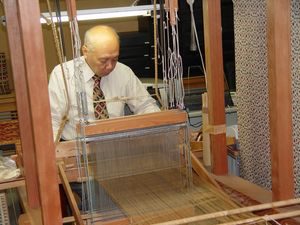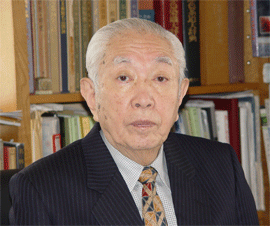当研究所は400年程前の名物裂(中国から舶載された染織品)と古渡更紗(印度)等の染織品を祖父 繁太郎、父 一,私一弘と三代に亘って収集、研究、復原をしています。
名物裂・古渡更紗は大名や茶の湯の数寄者たちを魅了し、名物裂(茶入れの織物の袋裂)として大変珍重され、今も大切に遺されています。古渡更紗(木綿生地に染色している)も茶の湯の世界で珍重されていました。
多くの芸術工芸は茶の湯との繋がりのお陰で遺されてきました。
渡来した更紗については1977年に「名物更紗類聚 鈴木一著」として出版。
名物裂は2007年に「名物裂事典 鈴木一著」として出版。
祖父 繁太郎は帝室博物館館蔵品と自身の収集品で構成された「印度更紗模様」を出版しました。
美しい染織品には、人に感動を与える力があります。その感動を伝えることができるならば幸甚です。
更紗の再現を始めて10数年たちますが、約400年前の柄とは思えないほどです。現在でも斬新な柄で、今でも人々を魅了します。最初に「格天井更紗」を再現したときに、展示販売してもらう場所はミュージアムショップと決めていました。美術に関心のある方たちが来られる場所で評価を得たいと考えたのでした。
ミュージアムショップでは諸外国の眼の肥えた人たちにも感動を与えたようです。
美しいものは世界共通であることを知りました。
我々は、本物をコレクションしていますので、再現に取り掛かっても本物を絶えず横に置き、できるだけ忠実に再現しています。
また、自社ビルの4階をコレクションルームにして、春:古渡更紗展、夏:竹屋町展、秋:名物裂展、冬:珍しい裂展として展示(非売)しています。
1階は再現した更紗等を展示販売しています。
京都へお越しの時はお立ち寄り下さい。
鈴木時代裂研究所
所長 鈴木 一弘

名物裂と古渡り更紗は、400年前、大名や茶道の巨匠達を魅了しました。21世紀のいまでも我々を虜にしています。
染織品は大別して、染めた裂、織った裂、縫った裂、編んだ裂の四つに大別されます。私が蒐集、研究している裂は、染められた裂である古渡り更紗と織られた裂である名物裂です。
名物裂は茶道と深い関係があります。名物裂の多くは17世紀から18世紀にかけて日本に輸入されました、そしてこれらの染織品にとって重要だったのは、日本の茶道の創生期から黄金時代への時期と重なっています。
多くの芸術工芸は茶道との繋がりのお陰で遺されてきました。 渡来した染織品の中から選び抜かれた裂は、大名や数奇者達によって、広く愛用されて茶道で様々な用具に使用されました。例えば、掛軸の一文字(掛軸の本体上下の裂)、風帯(掛軸の上から吊るした2本の裂)、茶碗の袋、茶入れの袋、帛紗等に使用されてきました。
私は小さい頃から絵を描くことが好きで、芸術に興味がありました。父が突然亡くなった後、私は父が遺した裂を整理して、染物・織物・国内・国外・年代順に分類し、独自に裂の蒐集、研究を続けてきました。50歳の時に古渡り更紗のコレクションを主にして『名物更紗類聚(1975年)』を出版しました。60歳で、私はこれ等染織品のコレクションの蒐集・研究・調査・復原の為に鈴木時代裂研究所を設立しました。その後『角川茶道大事典(1999年)』別冊で「名物裂総覧」を担当しました。私はこの10年の間名物裂の事典を出版すべく執筆に力を注いで参りました。そしてこの本は約100万字と6,700枚のカラー写真で編集しています。半世紀以上、裂と付き合うことになりました。美しい染織品には、人に感動を与える力があります。今でもそんな裂にめぐり合えた時の嬉しさは格別です、その感動を伝えたいと思います。
鈴木時代裂研究所
初代所長 鈴木 一
(~2009)

Sarasa fascinated daimyos 400 years ago.
So it is with us in the 21stcentury
Cloth is roughly classified into dyed, woven and knitted cloth. The types of textile that I have collected and researched are ko-watari sarasa (chintz) which is dyed cloth, and meibutsu-gire which is known as woven cloth.
Sarasa and meibutsu-gire are both closely related to the tea ceremony.
Ko-watari sarasa and meibutsu-gire were imported into Japan in the 17th and 18th centuries and the import of these fabrics coincided with the golden age of the Japanese tea ceremony. In my opinion, many works of art have been preserved thanks to the relation to the tea ceremony.
The fabrics were widely cherished by daimyo (feudal lords) as they were used for various items in the tea ceremony. For instance, these beautiful fabrics are used for ichi-monji (trims above and below the artwork of a hanging scroll), fuutai (strips hanging down vertically from the top edge of a hanging scroll) and shifuku (pouches) for teacups and containers of tea leaves, etc.From my childhood, I liked to paint and was interested in art in general.
After my father suddenly died, I sorted out the pieces of cloth that he had left and classified them into dyed, woven, domestic and foreign cloths. I then set out to research them further on my own. I compiled “Meibutsu Sarasa Ruiju (1975)” on our collection of sarasa. At the age of sixty I founded the Suzuki Research Institute of Ancient Textiles for the collection, research and reproduction of these textiles. I published on meibutsu-gire in a separate volume of “Kadokawa Sadoh Jiten (1999)”. I have been engaged in compiling a dictionary of meibutsu-gire for the last 10 years and this publication will consist of 870,000 characters and 6,700 pictures. It is scheduled to be published in recent future years.A beautiful fabric has the power to impress people. I have been engaged in Japanese ancient textiles for over half a century, but I am still fascinated whenever I come across an extraordinary example.
May 20, 2005Hajime SUZUKI